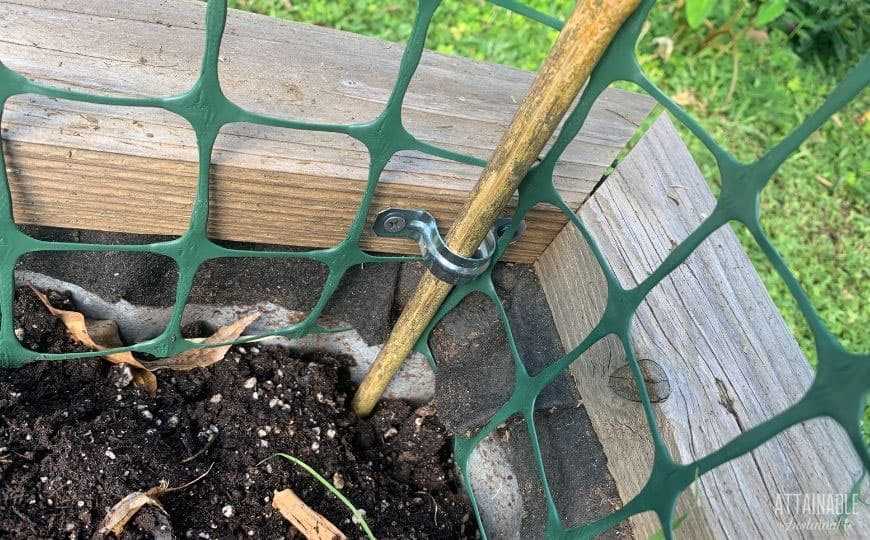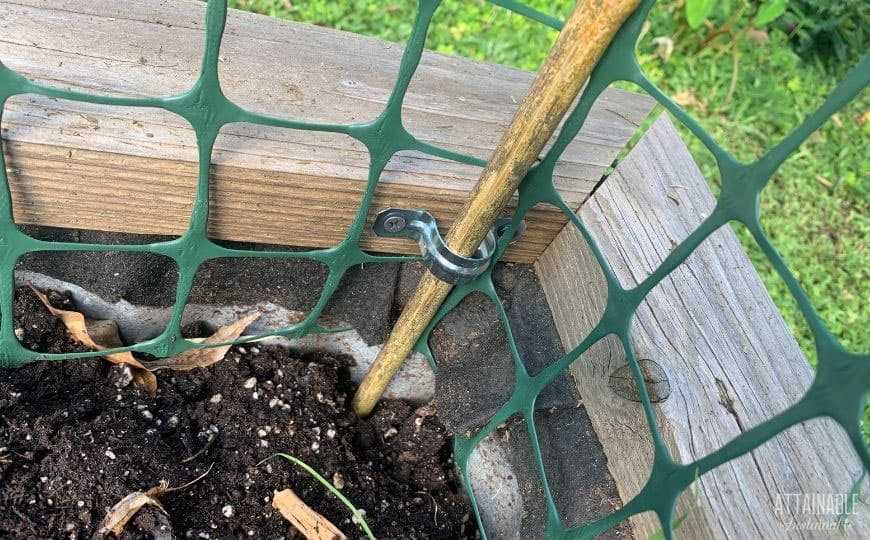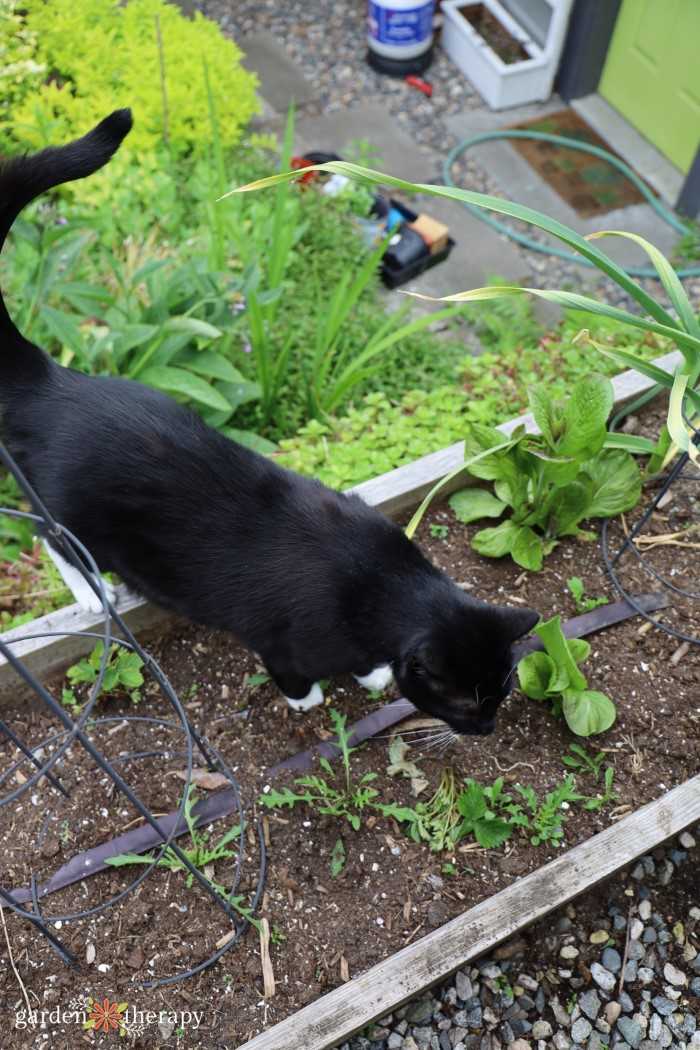Sprinkling citrus peels around the perimeter of my beloved plants works wonders. The strong scent acts as a natural deterrent, keeping those furry intruders at bay. In addition, using coffee grounds not only enriches the soil but also sends a clear message that this space is off-limits. A sprinkle here and there creates a barrier they tend to avoid.
Creating physical barriers is another smart tactic. Installing low fences or using chicken wire can protect delicate blooms from curious paws. I’ve found that the texture of wire is particularly uninviting for those who wish to explore my green domain. When combined with plant stakes or decorative rocks, it establishes a clear boundary without compromising aesthetics.
Utilizing motion-activated devices adds an extra layer of protection. Devices that emit bursts of water or sound can startle any would-be trespassers. I’ve seen firsthand how effective these gadgets can be in preserving my cherished flora from unwanted exploration.
Lastly, planting specific herbs like lavender or rosemary serves a dual purpose. These aromatic plants not only enhance my garden’s appeal but also repel those agile roamers with their scents. Creating a fragrant barrier is both a practical and delightful strategy to maintain the integrity of my green space.
Preventing Feline Intrusions in Plant Areas

Place citrus peels around the perimeter of the planting zones. The scent is unappealing to most felines and serves as a natural deterrent.
Install physical barriers like low fencing or chicken wire, which can restrict access while allowing sunlight and rain to nourish the plants.
Sprinkling cayenne pepper or coffee grounds in the soil can create an unpleasant experience for curious paws, steering them clear of the area.
Utilize motion-activated sprinklers that release a burst of water when they sense movement, providing an unexpected surprise to any intruder.
Consider planting rosemary, lavender, or other aromatic herbs that are often avoided by felines. Their strong fragrances can create an unwelcoming atmosphere.
Set up ultrasonic devices that emit high-frequency sounds, inaudible to humans but irritating to many animals, including those furry trespassers.
Regularly change the layout or introduce new elements to the surroundings, as unfamiliar scents and sights can dissuade return visits.
Using Natural Deterrents to Repel Cats

Citronella and eucalyptus oils effectively deter unwanted visitors. Mixing these oils with water and spraying around boundaries creates an unpleasant scent for intruders.
Crushed citrus peels, such as oranges and lemons, provide an aromatic barrier. Scatter them throughout the territory to enhance the sensory experience for those who wander too close.
Cayenne pepper serves as a powerful repellent. Sprinkling it around favorite spots may discourage curious felines from lingering.
Vinegar has a strong smell that many find unappealing. Diluting it with water and spraying in areas of concern can keep intruders at bay.
Planting rosemary, lavender, or rue not only beautifies but also creates a natural deterrent. These herbs are known to repel many four-legged visitors with their potent scents.
Motion-activated sprinklers can surprise and deter intruders effectively. The sudden burst of water creates an unexpected experience, encouraging quick exits.
Utilizing these natural methods can help maintain a peaceful environment without harm to any creatures. Always observe the results and adjust the approach as needed for the best outcomes.
Creating Physical Barriers for Garden Protection

To prevent unwanted visitors, consider installing sturdy fencing around the area. A height of at least 6 feet will deter most intruders. Ensure that the base of the fence is buried a few inches underground to stop digging.
Another effective method is to use chicken wire or hardware cloth. This material can be laid flat on the soil or formed into small barriers around vulnerable plants. Secure it with stakes to keep it in place.
Here are additional options to think about:
- Use raised beds: Elevating plants makes it harder for intruders to access them.
- Install mesh netting: A lightweight option that can cover plants and keep away troubles.
- Consider row covers: These can protect young seedlings from both pests and nosy animals.
For an extra layer of protection, create an obstacle course using stones, sticks, or other natural materials. This can confuse and dissuade curious paws.
Lastly, if you’re curious about cultural practices, you can learn more about the topic in this article: do people in china eat cats.
Implementing Scent and Sound Strategies

Using citrus peels, like oranges and lemons, effectively deters unwanted visitors. Placing these peels around the perimeter of the area can create an unpleasant environment for them. Another powerful natural repellent is vinegar. Spraying a diluted solution around the space can keep intruders at bay.
Incorporating essential oils, such as lavender or eucalyptus, offers a pleasant aroma for humans while being unappealing to felines. A few drops mixed with water in a spray bottle can serve as an effective deterrent. Remember to refresh these oils regularly for maximum impact.
Auditory deterrents can also play a significant role. High-frequency sound devices, imperceptible to human ears, can irritate sensitive animals and encourage them to move elsewhere. Alternatively, motion-activated devices that emit sounds or noises can startle and discourage unwanted visitors.
For a more gentle approach, consider wind chimes or similar items that create sounds when the wind blows. While not as intense as other strategies, this can still create an unwelcoming atmosphere. Combining these scent and sound methods with physical barriers improves overall effectiveness.
For those curious about plant options, consider checking if specific flowers, like pansies, are non-toxic by visiting are pansies cat safe. This ensures a safe environment while deterring unwanted guests.
Sprinkling citrus peels around the perimeter of my beloved plants works wonders. The strong scent acts as a natural deterrent, keeping those furry intruders at bay. In addition, using coffee grounds not only enriches the soil but also sends a clear message that this space is off-limits. A sprinkle here and there creates a barrier they tend to avoid.
Creating physical barriers is another smart tactic. Installing low fences or using chicken wire can protect delicate blooms from curious paws. I’ve found that the texture of wire is particularly uninviting for those who wish to explore my green domain. When combined with plant stakes or decorative rocks, it establishes a clear boundary without compromising aesthetics.
Utilizing motion-activated devices adds an extra layer of protection. Devices that emit bursts of water or sound can startle any would-be trespassers. I’ve seen firsthand how effective these gadgets can be in preserving my cherished flora from unwanted exploration.
Lastly, planting specific herbs like lavender or rosemary serves a dual purpose. These aromatic plants not only enhance my garden’s appeal but also repel those agile roamers with their scents. Creating a fragrant barrier is both a practical and delightful strategy to maintain the integrity of my green space.
Preventing Feline Intrusions in Plant Areas

Place citrus peels around the perimeter of the planting zones. The scent is unappealing to most felines and serves as a natural deterrent.
Install physical barriers like low fencing or chicken wire, which can restrict access while allowing sunlight and rain to nourish the plants.
Sprinkling cayenne pepper or coffee grounds in the soil can create an unpleasant experience for curious paws, steering them clear of the area.
Utilize motion-activated sprinklers that release a burst of water when they sense movement, providing an unexpected surprise to any intruder.
Consider planting rosemary, lavender, or other aromatic herbs that are often avoided by felines. Their strong fragrances can create an unwelcoming atmosphere.
Set up ultrasonic devices that emit high-frequency sounds, inaudible to humans but irritating to many animals, including those furry trespassers.
Regularly change the layout or introduce new elements to the surroundings, as unfamiliar scents and sights can dissuade return visits.
Using Natural Deterrents to Repel Cats

Citronella and eucalyptus oils effectively deter unwanted visitors. Mixing these oils with water and spraying around boundaries creates an unpleasant scent for intruders.
Crushed citrus peels, such as oranges and lemons, provide an aromatic barrier. Scatter them throughout the territory to enhance the sensory experience for those who wander too close.
Cayenne pepper serves as a powerful repellent. Sprinkling it around favorite spots may discourage curious felines from lingering.
Vinegar has a strong smell that many find unappealing. Diluting it with water and spraying in areas of concern can keep intruders at bay.
Planting rosemary, lavender, or rue not only beautifies but also creates a natural deterrent. These herbs are known to repel many four-legged visitors with their potent scents.
Motion-activated sprinklers can surprise and deter intruders effectively. The sudden burst of water creates an unexpected experience, encouraging quick exits.
Utilizing these natural methods can help maintain a peaceful environment without harm to any creatures. Always observe the results and adjust the approach as needed for the best outcomes.
Creating Physical Barriers for Garden Protection

To prevent unwanted visitors, consider installing sturdy fencing around the area. A height of at least 6 feet will deter most intruders. Ensure that the base of the fence is buried a few inches underground to stop digging.
Another effective method is to use chicken wire or hardware cloth. This material can be laid flat on the soil or formed into small barriers around vulnerable plants. Secure it with stakes to keep it in place.
Here are additional options to think about:
- Use raised beds: Elevating plants makes it harder for intruders to access them.
- Install mesh netting: A lightweight option that can cover plants and keep away troubles.
- Consider row covers: These can protect young seedlings from both pests and nosy animals.
For an extra layer of protection, create an obstacle course using stones, sticks, or other natural materials. This can confuse and dissuade curious paws.
Lastly, if you’re curious about cultural practices, you can learn more about the topic in this article: do people in china eat cats.
Implementing Scent and Sound Strategies

Using citrus peels, like oranges and lemons, effectively deters unwanted visitors. Placing these peels around the perimeter of the area can create an unpleasant environment for them. Another powerful natural repellent is vinegar. Spraying a diluted solution around the space can keep intruders at bay.
Incorporating essential oils, such as lavender or eucalyptus, offers a pleasant aroma for humans while being unappealing to felines. A few drops mixed with water in a spray bottle can serve as an effective deterrent. Remember to refresh these oils regularly for maximum impact.
Auditory deterrents can also play a significant role. High-frequency sound devices, imperceptible to human ears, can irritate sensitive animals and encourage them to move elsewhere. Alternatively, motion-activated devices that emit sounds or noises can startle and discourage unwanted visitors.
For a more gentle approach, consider wind chimes or similar items that create sounds when the wind blows. While not as intense as other strategies, this can still create an unwelcoming atmosphere. Combining these scent and sound methods with physical barriers improves overall effectiveness.
For those curious about plant options, consider checking if specific flowers, like pansies, are non-toxic by visiting are pansies cat safe. This ensures a safe environment while deterring unwanted guests.
Sprinkling citrus peels around the perimeter of my beloved plants works wonders. The strong scent acts as a natural deterrent, keeping those furry intruders at bay. In addition, using coffee grounds not only enriches the soil but also sends a clear message that this space is off-limits. A sprinkle here and there creates a barrier they tend to avoid.
Creating physical barriers is another smart tactic. Installing low fences or using chicken wire can protect delicate blooms from curious paws. I’ve found that the texture of wire is particularly uninviting for those who wish to explore my green domain. When combined with plant stakes or decorative rocks, it establishes a clear boundary without compromising aesthetics.
Utilizing motion-activated devices adds an extra layer of protection. Devices that emit bursts of water or sound can startle any would-be trespassers. I’ve seen firsthand how effective these gadgets can be in preserving my cherished flora from unwanted exploration.
Lastly, planting specific herbs like lavender or rosemary serves a dual purpose. These aromatic plants not only enhance my garden’s appeal but also repel those agile roamers with their scents. Creating a fragrant barrier is both a practical and delightful strategy to maintain the integrity of my green space.
Preventing Feline Intrusions in Plant Areas

Place citrus peels around the perimeter of the planting zones. The scent is unappealing to most felines and serves as a natural deterrent.
Install physical barriers like low fencing or chicken wire, which can restrict access while allowing sunlight and rain to nourish the plants.
Sprinkling cayenne pepper or coffee grounds in the soil can create an unpleasant experience for curious paws, steering them clear of the area.
Utilize motion-activated sprinklers that release a burst of water when they sense movement, providing an unexpected surprise to any intruder.
Consider planting rosemary, lavender, or other aromatic herbs that are often avoided by felines. Their strong fragrances can create an unwelcoming atmosphere.
Set up ultrasonic devices that emit high-frequency sounds, inaudible to humans but irritating to many animals, including those furry trespassers.
Regularly change the layout or introduce new elements to the surroundings, as unfamiliar scents and sights can dissuade return visits.
Using Natural Deterrents to Repel Cats

Citronella and eucalyptus oils effectively deter unwanted visitors. Mixing these oils with water and spraying around boundaries creates an unpleasant scent for intruders.
Crushed citrus peels, such as oranges and lemons, provide an aromatic barrier. Scatter them throughout the territory to enhance the sensory experience for those who wander too close.
Cayenne pepper serves as a powerful repellent. Sprinkling it around favorite spots may discourage curious felines from lingering.
Vinegar has a strong smell that many find unappealing. Diluting it with water and spraying in areas of concern can keep intruders at bay.
Planting rosemary, lavender, or rue not only beautifies but also creates a natural deterrent. These herbs are known to repel many four-legged visitors with their potent scents.
Motion-activated sprinklers can surprise and deter intruders effectively. The sudden burst of water creates an unexpected experience, encouraging quick exits.
Utilizing these natural methods can help maintain a peaceful environment without harm to any creatures. Always observe the results and adjust the approach as needed for the best outcomes.
Creating Physical Barriers for Garden Protection

To prevent unwanted visitors, consider installing sturdy fencing around the area. A height of at least 6 feet will deter most intruders. Ensure that the base of the fence is buried a few inches underground to stop digging.
Another effective method is to use chicken wire or hardware cloth. This material can be laid flat on the soil or formed into small barriers around vulnerable plants. Secure it with stakes to keep it in place.
Here are additional options to think about:
- Use raised beds: Elevating plants makes it harder for intruders to access them.
- Install mesh netting: A lightweight option that can cover plants and keep away troubles.
- Consider row covers: These can protect young seedlings from both pests and nosy animals.
For an extra layer of protection, create an obstacle course using stones, sticks, or other natural materials. This can confuse and dissuade curious paws.
Lastly, if you’re curious about cultural practices, you can learn more about the topic in this article: do people in china eat cats.
Implementing Scent and Sound Strategies

Using citrus peels, like oranges and lemons, effectively deters unwanted visitors. Placing these peels around the perimeter of the area can create an unpleasant environment for them. Another powerful natural repellent is vinegar. Spraying a diluted solution around the space can keep intruders at bay.
Incorporating essential oils, such as lavender or eucalyptus, offers a pleasant aroma for humans while being unappealing to felines. A few drops mixed with water in a spray bottle can serve as an effective deterrent. Remember to refresh these oils regularly for maximum impact.
Auditory deterrents can also play a significant role. High-frequency sound devices, imperceptible to human ears, can irritate sensitive animals and encourage them to move elsewhere. Alternatively, motion-activated devices that emit sounds or noises can startle and discourage unwanted visitors.
For a more gentle approach, consider wind chimes or similar items that create sounds when the wind blows. While not as intense as other strategies, this can still create an unwelcoming atmosphere. Combining these scent and sound methods with physical barriers improves overall effectiveness.
For those curious about plant options, consider checking if specific flowers, like pansies, are non-toxic by visiting are pansies cat safe. This ensures a safe environment while deterring unwanted guests.






